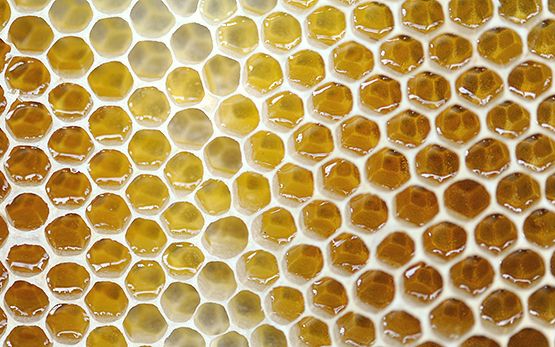Der Wassergehalt des von den Pflanzen produzierten Nektars kann variieren. Um seine Konservierung in den Waben zu gewährleisten, darf er nicht gären. Deshalb wird er von den Bienen in Honig umgewandelt, indem sie seinen Wassergehalt senken und folglich den Zuckergehalt erhöhen. Dies verhindert die Entwicklung der Mikroorganismen. In der Dunkelheit des Bienenstocks ist es schwierig, den Herstellungsprozess des Honigs zu beobachten. Aus diesem Grund ist er auch nur wenig erforscht. Um die Umwandlung von Nektar in Honig zu untersuchen, haben wir die Technik der Tomographie eingesetzt. Sie ermöglicht es, den Zuckergehalt des eingelagerten Nektars sehr präzise zu messen, ohne den Bienenstock öffnen zu müssen und das Bienenvolk zu stören.

Pubblicazioni Matthias Albrecht
Senapathi D., Fründ J., Albrecht M., Garratt M.P.D., Kleijn D., Pickles B.J., Potts S.G., An J., Andersson G.K.S., Bänsch S., Basu P., Benjamin F., Bezerra A.D.M., Bhattacharya R., Biesmeijer J.C. e altri
Wild insect diversity increases interannual stability in global crop pollinator communities.
Proceedings of the Royal Society B: Biological Sciences, 288, (1947), 2021.
Eckerter P.W., Albus L., Nataranjan S., Albrecht M., Ammann L., Gobet E., Herzog F., Tinner W., Entling M.H.
Using temporally resolved floral resource maps to explain bumblebee colony performance in agricultural landscapes.
Agronomy, 10, (12), 2020, 1-16.
Ammann L., Moorhouse-Gann R., Cuff J., Bertrand C., Mestre C., Hildago N.P., Ellison A., Herzog F., Entling M.H., Albrecht M., Symondson W.O.C.
Insights into aphid prey consumption by ladybirds: Optimising field sampling methods and primer design for high throughput sequencing.
PLOS ONE, 15, (7), 2020, 1-20.
Cole L.J., Kleijn D., Dicks L.V., Stout J.C., Potts S.G., Albrecht M., Balzan M., Bartomeus I., Bebeli P.J., Bevk D., Biesmeijer J.C., Chlebo R., Dautarté A., Emmanouil N., Hartfield C. e altri
A critical analysis of the potential for EU Common Agricultural Policy measures to support wild pollinators on farmland.
Journal of Applied Ecology, 57, (4), 2020, 681-694.
Ganser D., Albrecht M., Knop E.
Wildflower strips enhance wild bee reproductive success.
Journal of Applied Ecology, online, (11 October), 2020, 1-10.
Albrecht M., Kleijn D., Williams N. M., Tschumi M., Blaauw B. R., Bommarco R., Campbell A. J., Dainese M., Drummond F. A., Entling M. H., Ganser D., de Groot G. A., Goulson D., Grab H., Hamilton H. e altri
The effectiveness of flower strips and hedgerows on pest control, pollination services and crop yield: a quantitative synthesis.
Ecology Letters, 23, (10), 2020, 1488-1498.
Holland J. M., Sutter L., Albrecht M., Jeanneret P., Pfister S. C., Schirmel J., Entling M. H., Kaasik R., Kovacs G., Veromann E., Bartual A. M., Marini S., Moonen A.-C., Szalai M., Helsen H. e altri
Moderate pollination limitation in some entomophilous crops of Europe.
Agriculture, Ecosystems & Environment, 302, 2020, 1-5.
Kay S., Kühn E., Albrecht M., Sutter L., Szerencsits E., Herzog F.
Agroforestry can enhance foraging and nesting resources for pollinators with focus on solitary bees at the landscape scale.
Agroforestry Systems, 94, 2020, 379-387.
Strobl V., Albrecht M., Radford S., Wolf S., Neumann P.
A short note on extreme sex ratio in solitary bees Osmia cornuta in semi-field trials testing the impact of neonicotinoids.
Journal of Apicultural Research, 58, (3), 2020, 469-470.
Ekroos J., Kleijn D. , Batáry P., Albrecht M., Báldi A., Blüthgen N., Knop E., Kovács-Hostyánszki A., Smith H. G.
High land-use intensity in grasslands constrains wild bee species richness in Europe.
Biological Conservation, 241, (January), 2020, 1-8.
Albrecht M., Herzog F.
Hilfe für hungrige Nützlinge in Feld.
Zürcher Umweltpraxis, 95, 2019, 31-32.
Dainese M., Martin E. A., Aizen M. A., Albrecht M., Bartomeus I., Bommarco R., Carvalheiro L. G., Chaplin-Kramer R., Gagic V., Garibaldi L. A., Ghazoul J., Grab H., Jonsson M., Karp D. S., Kennedy C. M. e altri
A global synthesis reveals biodiversity-mediated benefits for crop production.
Science Advances, 5, (10), 2019, 1-13.
Ganser D., Sutter L., Herzog F., Albrecht M.
Honig- und Wildbienen ergänzen sich bei der Bestäubung landwirtschaftlicher Kulturen.
Schweizerische Bienen-Zeitung, 6, 2019, 21-24.
Bertrand C., Eckerter P.W., Ammann L., Entling M.H., Gobet E., Herzog F., Mestre L., Tinner W., Albrecht M.
Seasonal shifts and complementary use of pollen sources by two bees, a lacewing and a ladybeetle species in European agricultural landscapes.
Journal of Applied Ecology, online, (26 August), 2019, 1-12.
Sutter L., Ganser D., Herzog F., Albrecht M.
Wildbienen - die unterschätzten Helfer.
Schweizer Zeitschrift für Obst- und Weinbau, 11, 2019, 12-14.
Strobl V., Albrecht M., Neumann P.
Trypanosomatid parasites infecting managed honeybees and wild solitary bees.
International Journal for Parasitology, 49, (8), 2019, 605-613.
Martin E.A., Dainese M., Clough Y., Baldi A., Bommarco R., Gagic V., Garratt M.P.D., Holzschuh A., Kleijn D., Kovacs-Hostyanski A., Marini L., Potts S.G., Smith H.G., Al Hassan D., Albrecht M. e altri
The interplay of landscape composition and configuration: new pathways to manage functional biodiversity and agroecosystem services across Europe.
Ecology Letters, online, (April), 2019, 1-12.
Kremen C., Albrecht M., Ponisio L.
Restoring pollinator communities and pollination services in hedgerows in intensively managed agricultural landscapes.
In: The ecology of hedgerows and field margins. 15 Januar, Ed. John W. Dover, Routledge, London and New York. 2019, 163-185.
Strobl V., Straub L., Bruckner S., Albrecht M., Jakkrawut M., Kolari E., Chantawannakul P., Williams G., Neumann P.
Not every sperm counts: Male fertility in solitary bees, Osmia cornuta.
PLOS ONE, 14, (3), 2019, 1-17.
Gueuning M., Ganser D., Blaser S., Albrecht M., Knop E., Praz C., Frey J. E.
Evaluating NGS methods for routine monitoring of wild bees: metabarcoding, mitogenomics or NGS bar-coding.
Molecular Ecology Resources, (2 März), 2019.





